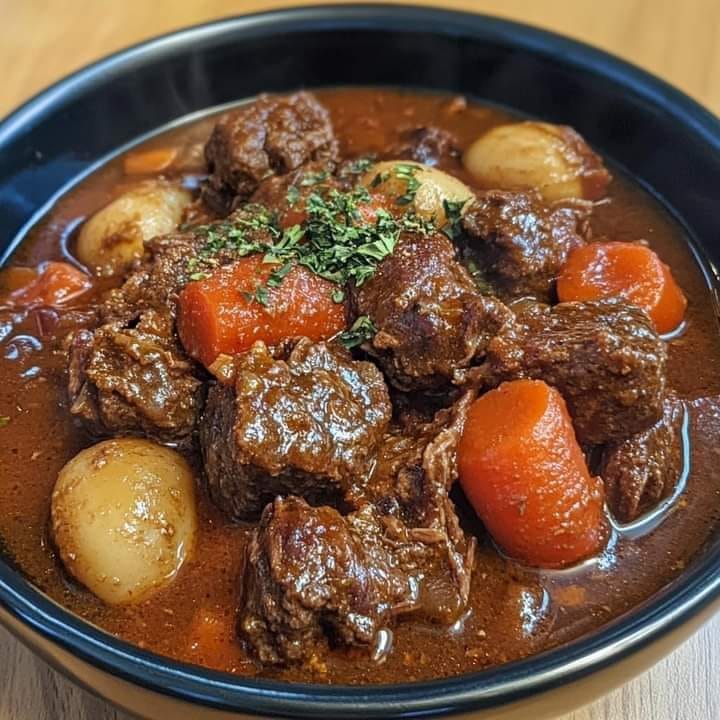- Season the Beef
Generously season the beef cubes with salt and pepper. This helps to build flavor right from the start. - Sear the Beef
In a large, heavy-bottomed pot or Dutch oven, heat 2 tablespoons of olive oil over medium-high heat. Sear the beef in batches until each piece is browned on all sides, about 4-5 minutes per batch. Avoid overcrowding the pot to ensure a good sear. Set the beef aside.
Step 2: Building the Base
- Sauté the Onions and Garlic
Lower the heat to medium and add the remaining tablespoon of olive oil to the pot. Add the onions, stirring until they become translucent and start to caramelize, about 5 minutes. Add the minced garlic and cook for another minute until fragrant. - Add Tomato Paste and Flour
Stir in the tomato paste, coating the onions and garlic. Cook for 2 minutes, allowing it to deepen in color, then sprinkle the flour over the mixture. Stir for another 2-3 minutes to cook out the raw flour taste.
Step 3: Creating the Broth
- Deglaze with Wine and Broth
Pour in the red wine, scraping the bottom of the pot to release any browned bits (if you’re skipping the wine, go straight to the broth). Allow it to simmer for 2-3 minutes until reduced by half, then add the beef broth. - Season the Broth
Stir in the Worcestershire sauce, thyme, and bay leaves. Season with a bit more salt and pepper, then return the seared beef to the pot. Bring to a simmer.
Step 4: Adding the Vegetables
- Add Potatoes, Carrots, and Celery
Add the potatoes, carrots, and celery to the pot, ensuring they’re submerged in the liquid. - Simmer Until Tender
Cover the pot with a lid and reduce the heat to low. Let the stew simmer gently for 1.5 to 2 hours, stirring occasionally. Check for tenderness: the beef and vegetables should be fork-tender, and the broth should be rich and thickened.
Step 5: Finishing Touches
- Add Frozen Peas
About 10 minutes before serving, stir in the frozen peas. They add a pop of color and a hint of sweetness that balances the savory flavors. - Adjust Seasoning
Taste the stew and adjust the salt, pepper, or Worcestershire sauce as needed. For extra depth, add a pinch of sugar if desired. - Garnish and Serve
Ladle the stew into bowls and sprinkle with fresh chopped parsley. Serve with warm crusty bread or over mashed potatoes for a hearty, filling meal.
Tips for the Best Beef Stew
- Use Chuck Roast for Tenderness: Chuck roast has a good amount of marbling, which breaks down during slow cooking and results in tender, flavorful beef.
- Brown the Beef in Batches: This step enhances the stew’s flavor. Avoid crowding the pot to ensure each piece gets a nice, caramelized crust.
- Allow Time for a Slow Simmer: Low and slow cooking ensures all the flavors meld together, creating a stew with a deeply savory taste and melt-in-your-mouth texture.
- Balance the Flavors: Worcestershire sauce adds umami, while a dash of sugar or balsamic vinegar can balance the savory flavors with a touch of sweetness.
- Thicken the Broth if Desired: If the stew’s broth isn’t thick enough, remove the lid and let it simmer uncovered for 15-20 minutes before adding the peas.
Storage Tips
- Refrigerate: Store leftovers in an airtight container in the refrigerator for up to 3 days. Beef stew flavors only get better with time!
- Freeze: This stew freezes well. Freeze individual portions in airtight containers for up to 3 months. Reheat on the stovetop for the best texture.
Final Thoughts on Beef Stew
This Best-Ever Beef Stew is a true classic that’s always a hit. Whether it’s a chilly day or you’re simply craving comfort food, this stew is a bowl of warmth and satisfaction. The layers of flavor, from the tender beef to the perfectly cooked vegetables, make this a timeless recipe for gatherings or quiet evenings at home. Enjoy every spoonful and let it warm you to the core!
